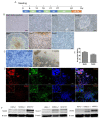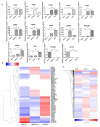Conversion of Human Fibroblasts into Induced Neural Stem Cells by Small Molecules
- PMID: 35163660
- PMCID: PMC8835839
- DOI: 10.3390/ijms23031740
Conversion of Human Fibroblasts into Induced Neural Stem Cells by Small Molecules
Abstract
Induced neural stem cells (iNSCs) reprogrammed from somatic cells hold great potentials for drug discovery, disease modelling and the treatment of neurological diseases. Although studies have shown that human somatic cells can be converted into iNSCs by introducing transcription factors, these iNSCs are unlikely to be used for clinical application due to the safety concern of using exogenous genes and viral transduction vectors. Here, we report the successful conversion of human fibroblasts into iNSCs using a cocktail of small molecules. Furthermore, our results demonstrate that these human iNSCs (hiNSCs) have similar gene expression profiles to bona fide NSCs, can proliferate, and are capable of differentiating into glial cells and functional neurons. This study collectively describes a novel approach based on small molecules to produce hiNSCs from human fibroblasts, which may be useful for both research and therapeutic purposes.
Keywords: human fibroblasts; induced neuron stem cells; small molecules.
Conflict of interest statement
The authors declare no conflict of interest.
Figures






Similar articles
-
Direct conversion of fibroblasts into stably expandable neural stem cells.Cell Stem Cell. 2012 Apr 6;10(4):473-9. doi: 10.1016/j.stem.2012.03.003. Epub 2012 Mar 22. Cell Stem Cell. 2012. PMID: 22445518
-
Direct reprogramming of fibroblasts into neural stem cells by single non-neural progenitor transcription factor Ptf1a.Nat Commun. 2018 Jul 20;9(1):2865. doi: 10.1038/s41467-018-05209-1. Nat Commun. 2018. PMID: 30030434 Free PMC article.
-
A combination of small molecules directly reprograms mouse fibroblasts into neural stem cells.Biochem Biophys Res Commun. 2016 Jul 15;476(1):42-8. doi: 10.1016/j.bbrc.2016.05.080. Epub 2016 May 17. Biochem Biophys Res Commun. 2016. PMID: 27207831
-
Take the shortcut - direct conversion of somatic cells into induced neural stem cells and their biomedical applications.FEBS Lett. 2019 Dec;593(23):3353-3369. doi: 10.1002/1873-3468.13656. Epub 2019 Dec 1. FEBS Lett. 2019. PMID: 31663609 Free PMC article. Review.
-
Reprogramming of somatic cells to induced neural stem cells.Methods. 2018 Jan 15;133:21-28. doi: 10.1016/j.ymeth.2017.09.007. Epub 2017 Sep 20. Methods. 2018. PMID: 28939501 Review.
Cited by
-
Strategies for modeling aging and age-related diseases.NPJ Aging. 2024 Jul 10;10(1):32. doi: 10.1038/s41514-024-00161-5. NPJ Aging. 2024. PMID: 38987252 Free PMC article. Review.
References
-
- McGinley L.M., Kashlan O.N., Bruno E.S., Chen K.S., Hayes J.M., Kashlan S.R., Raykin J., Johe K., Murphy G.G., Feldman E.L. Human neural stem cell transplantation improves cognition in a murine model of alzheimer’s disease. Sci. Rep. 2018;8:14776. doi: 10.1038/s41598-018-33017-6. - DOI - PMC - PubMed
-
- Kokaia Z., Darsalia V. Human neural stem cells for ischemic stroke treatment. Results Probl. Cell Differ. 2018;66:249–263. - PubMed
MeSH terms
Substances
LinkOut - more resources
Full Text Sources

